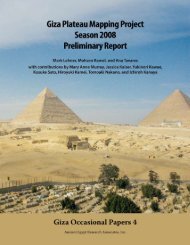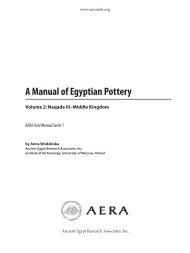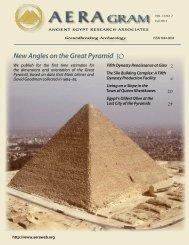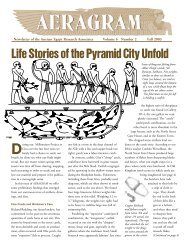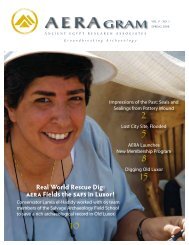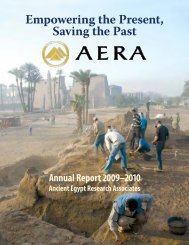Download a PDF of our 2009 Annual Report - Ancient Egypt ...
Download a PDF of our 2009 Annual Report - Ancient Egypt ...
Download a PDF of our 2009 Annual Report - Ancient Egypt ...
Create successful ePaper yourself
Turn your PDF publications into a flip-book with our unique Google optimized e-Paper software.
The first two volumes <strong>of</strong> A Manual <strong>of</strong> <strong>Egypt</strong>ian Pottery, in spiral and perfect-bound editions,<br />
“pose” on the stack <strong>of</strong> boxes in which the manuals were delivered to the Boston AERA <strong>of</strong>fices.<br />
Left: Author Dr. Anna Wodzińska.<br />
vessels; gaming pieces; tokens; inscribed, painted, or incised<br />
objects; burial objects; faience, personal adornment, and fragile/fine<br />
objects; and re-cut ceramic sherds later used as tools.<br />
Each category requires a different type <strong>of</strong> storage and artifactspecific<br />
ways to record the details <strong>of</strong> the objects.<br />
Emmy Malak designed the artifact database with a view<br />
to the ease <strong>of</strong> access. Emmy also worked closely with <strong>our</strong> new<br />
geologist, Philip LaPorta, who identified the raw materials in<br />
many <strong>of</strong> the artifact categories. The team drew and photographed<br />
objects to keep up with basic recording.<br />
Lithics<br />
Marina Milić, from Serbia, analyzes <strong>our</strong> lithics. “Lithics” refers<br />
to all chipped stone tools and/or flakes and other debris produced<br />
during the manufacture <strong>of</strong> tools (usually made <strong>of</strong> chert).<br />
In the <strong>2009</strong> season Marina largely focused on the final write-up<br />
<strong>of</strong> the RAB report.<br />
For Marina and all <strong>of</strong> the specialists, checking and correcting<br />
the database was also a priority. The analytical team works<br />
from the comprehensive RAB “synoptic” feature list, which<br />
includes all the information about a deposit required to complete<br />
statistics, graphs, charts, and a final interpretation. They<br />
work closely with GIS team members who create distribution<br />
maps <strong>of</strong> chipped tool types, for example, and who furnish other<br />
information for the various spatial and temporal variables associated<br />
with the RAB.<br />
As it was only Marina’s second season at Giza, her research<br />
also included reading as many relevant lithics articles as possible<br />
from the wider region to get a better idea about the nature<br />
<strong>of</strong> the Giza chipped stone within the <strong>Egypt</strong>ian context and<br />
beyond.<br />
Ceramics<br />
The ceramics team, headed by Dr. Anna Wodzińska, accomplished<br />
many tasks this season, including the analysis <strong>of</strong> the<br />
<strong>2009</strong> pottery from the Khentkawes town and the main HeG<br />
site. The team completed drawings and photographs <strong>of</strong> the pottery<br />
from the two sites.<br />
The KKT material makes a fascinating contrast to the HeG<br />
site ceramics in terms <strong>of</strong> style (e.g., many miniature votive <strong>of</strong>ferings)<br />
and the later date <strong>of</strong> the KKT assemblage, which includes<br />
pottery from the 4th, 5th, and 6th Dynasties, long after the Lost<br />
City was abandoned.<br />
Two volumes <strong>of</strong> Anna Wodzińska’s A Manual <strong>of</strong> <strong>Egypt</strong>ian<br />
Pottery were printed in time for the 20th Anniversary celebrations.<br />
The remaining two volumes <strong>of</strong> the manual are now<br />
complete and are currently being peer-reviewed prior to their<br />
imminent publication. This invaluable res<strong>our</strong>ce describes and<br />
illustrates ceramics from all periods <strong>of</strong> <strong>Egypt</strong>ian history, from<br />
the earliest Predynastic periods to traditional, modern <strong>Egypt</strong>ian<br />
pottery. Anna also completed her comprehensive report on the<br />
ceramics from the RAB.<br />
Archaeozoology<br />
Dr. Richard Redding had three goals for his research on animal<br />
bone in <strong>2009</strong>:<br />
1. Finish identifying all the bird bone from HeG and KKT to<br />
date. He identified the species <strong>of</strong> more than 500 fragments,<br />
most <strong>of</strong> which were ducks and geese. But the identifications<br />
also included common sparrow and <strong>Egypt</strong>ian vulture.<br />
2. Finish analyzing animal bone from RAB. The final report<br />
now awaits editing for publication.<br />
25





